On a bright morning last week, I watched a group of preschoolers playing at the top of a hillside above Mallard Lake. Some were climbing along a big log and taking turns jumping off the highest end. Others were building a fort around the remnants of a fallen eucalyptus tree, “painting” the sides green with smushed leaves. Two were ferrying piles of dirt onto a log and patting it into place. Several were plucking sour grass and munching on it.
School was in session.
The Little Forest Explorers school, that is — a program whose classroom is comprised of the woods and meadows of Golden Gate Park. Rain or shine, the 16 students and five teachers spend every school day in the park, playing, exploring and learning. I first came across the program last fall on a day when it was pouring rain. There was a line of wagons in the underpass by the Polo Fields and a gaggle of kids in bright rainboots were stomping and splashing in every puddle they could find, splattering themselves with mud. As the school’s website promises, “Your child will come home dirty every day and yes, you will need to pack extra clothes.”
I contacted Laura Engel, the school’s founder to learn more about her school and forest schools in general. Forest schools began in Denmark and Sweden in the 1950s, as a way to promote a connection between children and nature. But forest schooling has evolved into something more than outdoors education; it’s also pedagogic philosophy that stresses self-directed learning, play and supported risk-taking as key ways to build children’s social and physical skills and confidence.
There are currently four forest schools permitted to operate in Golden Gate Park: Little Forest Explorers, Little Earthlings Forest School, Forest Bloom School and the longest-running of the bunch, Wise Forest Preschool, which started in 2014. But there are “lots more” in the park without a permit, says Engel, as well as others based in The Presidio or that rotate among various parks.
Engel started Little Forest Explorers in 2020 after a decade of teaching in traditional public and private schools left her disenchanted by conventional indoor schooling. Whether in the classroom or on the playground, “it was an environment where children are forced to do what we want them to do, when we want them to do it, how we want them to do it,” she said. What young children really need, she came to believe, was to be outside in nature, following their curiosity. “Nature is a child’s best friend,” she says.
The pandemic provided the opportunity for her to pursue that vision. She was laid off, and her former students were cooped up inside, staring at teachers over Zoom. She thought to herself “what better time to start an outdoors school?” She happened to meet the director of Little Earthlings, and asked if she could observe it for a day. “Within the first five minutes, I knew this is how it should be.”
Schools starts at 9 and runs til 3. While some other forest schools have a regular meeting place, Engel changes locations every few days to ensure the kids stay engaged.
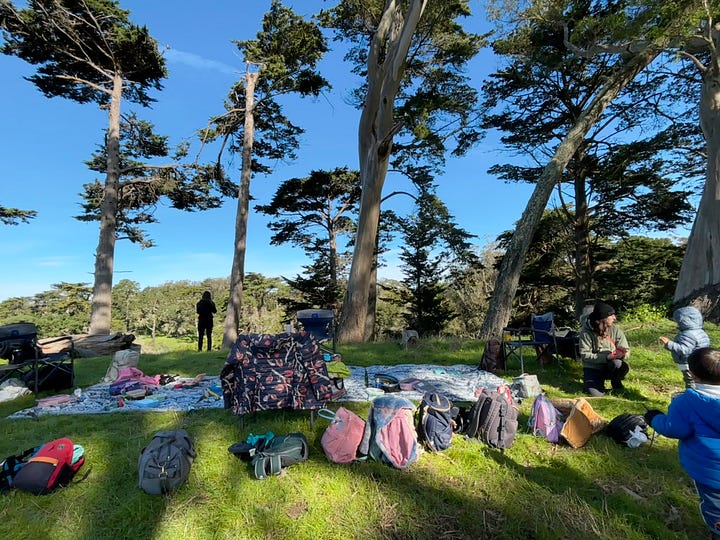
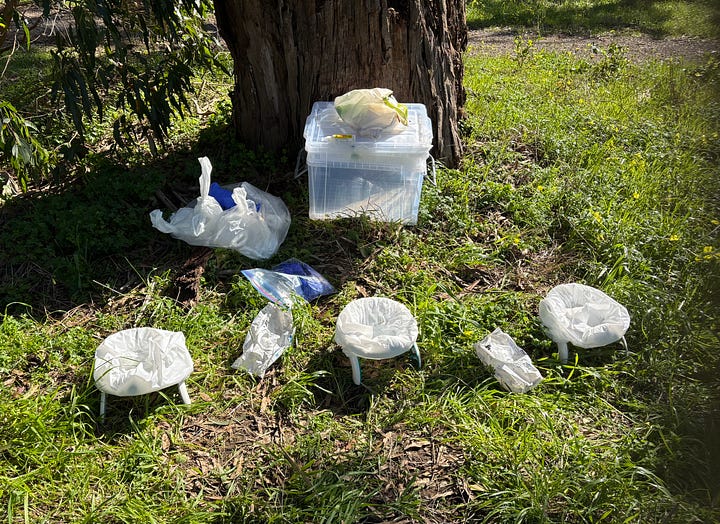
The days are mostly unstructured with the kids free to play as they wish. Watching them flow around the trees and trails that morning I was reminded how well kids can keep themselves engaged when left to their own imaginations. Though the teachers may bring supplies for projects, there are no commercial toys. The only plastic I saw onsite were the kids’ lunchboxes and thermoses and three little potties.
Instead, the children use what they find around them for their play. A log becomes a stage for an impromptu show. A branch becomes the roof of a house. A tipped-over giant tree root becomes a fort and then a kitchen and then a storefront. A collection of pebbles on a piece of bark becomes a bug habitat. To join in the fun calls for verbal skills and cooperation, which may be one reason the students all communicate at levels beyond their years, according to Engel.
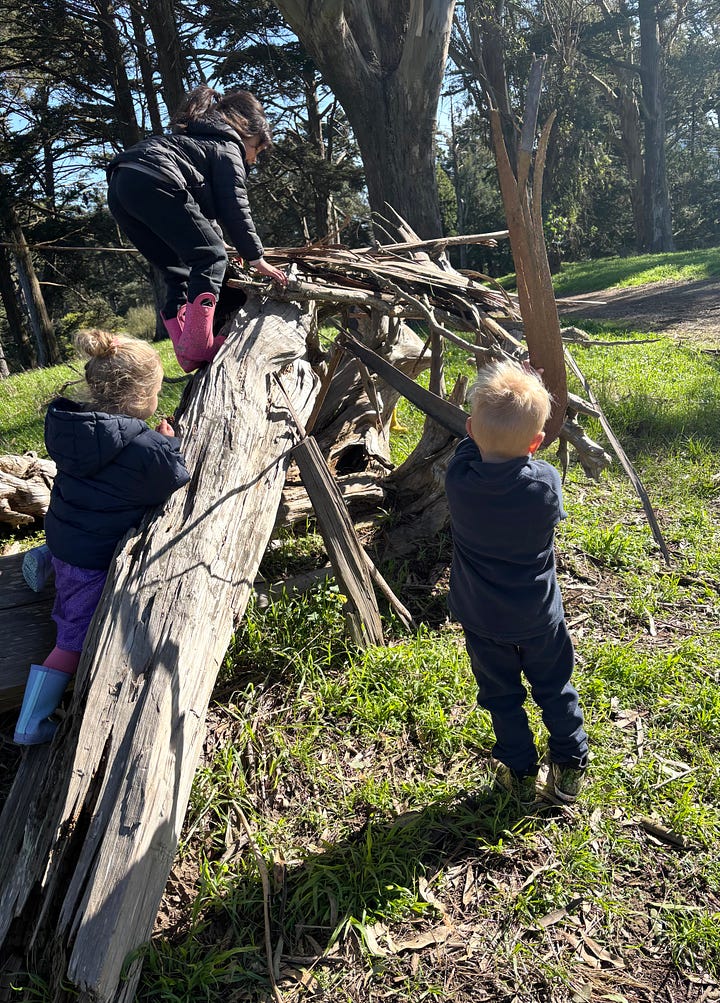
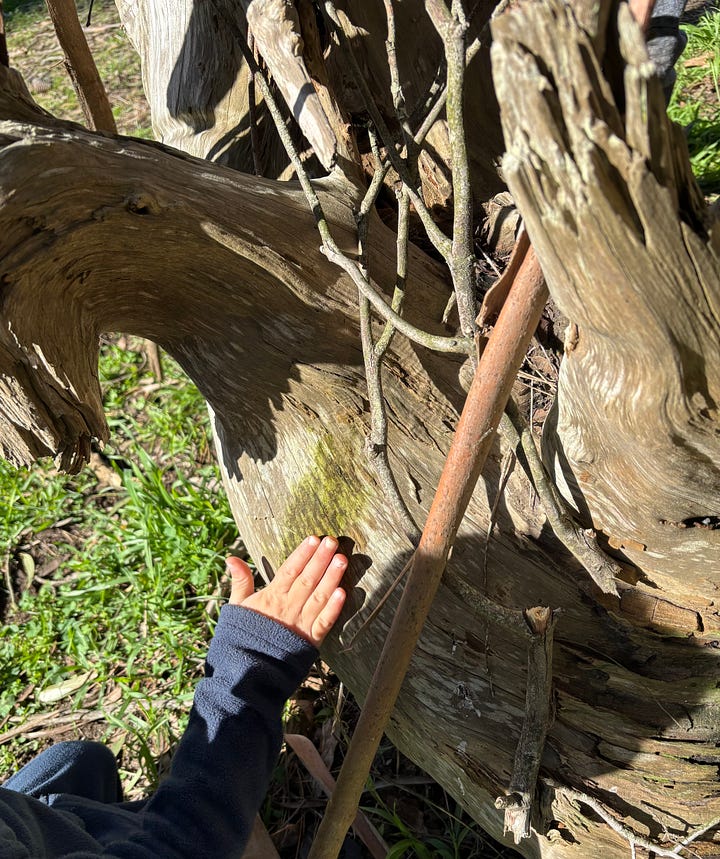
That freedom and immersion in the natural world is precisely why Shalico McGee and his partner wanted a forest school for their two-year-old daughter Moxie. It makes them “so much more confident with their bodies and language development,” said McGee. “And they get the most beautiful playground. Wouldn’t you want these memories of growing up like Alice in Wonderland in Golden Gate Park?”
Engel and the teachers hovered nearby without helicoptering in the slightest way. They stepped in only when someone asked for help or to help the kids work through tiffs or disagreements. As much as possible they let the kids challenge themselves with calculated risks -- a key tenet of forest schooling.
So when several of the youngest children headed for a tangle of tea trees bordering busy Lincoln Avenue, Engel just followed. She watched one boy inch his way along a branch in the direction of the street. When she decided he was no longer a safe distance from the road, she asked him to turn around. At first, he ignored her. “If you can’t listen and be safe with your body, I’m going to have to take you down,” she said. “Okay,” he said and tried backing up, but had trouble with the maneuver. “Do you need my help?” she finally asked. “Help,” he answered and she put her arms on either side to steady him as he backed down.
In fact, the park, unlike an indoors classroom, is rife with potential dangers. So at morning circle every day, the teachers remind them of the hazards and help them think of ways to stay safe. “It can be how can we be safe while we're climbing logs? How can we be safe while we're playing with sticks? What do we do if we see a wasp, for example? How can we be safe when we're holding insects and bugs? How can we keep the insects and bugs safe? Because this is their home,” said teacher Sienna Melton. “They all know how to yell ‘coyote’ when they see one and run to a teacher.”
The kids know their way around the park and are often the ones scouting out new locations for campsites. “They know all the edible plants in the park: the sour grass, miner’s lettuce, nasturtium, onions, blackberries,” said Willow, one of the teachers.
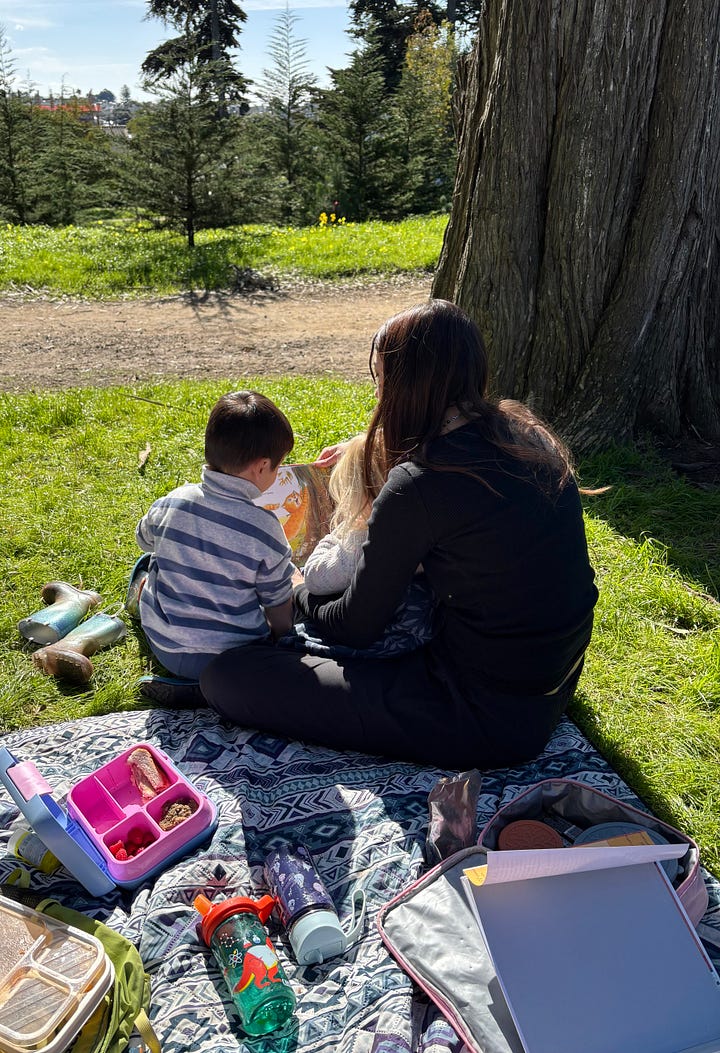
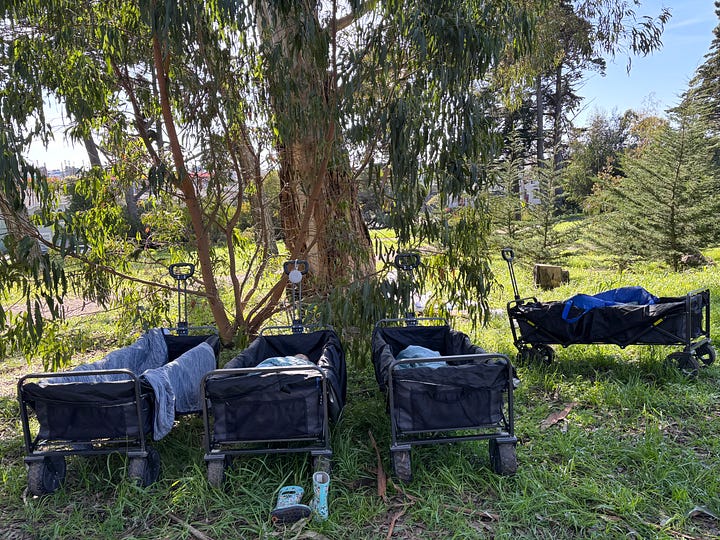
While the program isn’t academic in any way, Engel recognizes her students need to have some basic skills down for kindergarten. (Or first grade, for the few who are already kindergarten age.) They need to know how to hold a pencil or use scissors, recognize some numbers and letters. So, part of each day is set aside for lessons, often drawing on what the park provides. For art on Tuesdays, they may use berries and leaves to paint a picture. For math class on Thursdays, the kids may gather pine cones and sort them in piles for a lesson on less and more, or the teachers may post numbers on the trees and ask the kids to find specific numerals. Fridays are for STEM learning, such as building a boat from sticks and leaves and then testing it in one of the lakes or little streams until they can get it to float. Or they may spend the day on a cooking project, gathering sticks to build a fire in one of barbecue grills and then cutting up veggies to make soup.
To Engel’s surprise, the kids love lesson time. It’s their favorite part of each day. “It just really reinforced in me that when the physical and emotional aspects of a child's day are cared for, they drink up academics.”
Interestingly, some observers came to the same conclusion more than a century ago, when the park became the classroom for young refugees of the 1906 earthquake.
After the earthquake, the city set up tent schools for some 800 children living with their families in the park. School officials recognized it would be near-impossible to deliver standard lessons under the circumstances. “Children will not pore over books and slates. The work will be largely in nature study, and the high school teachers proficient in natural sciences will be employed. The tent schools will resemble the open-sky academies of old Greece and Rome,” The San Francisco Call reported on May 18, 1906, days before the schools opened.
What that meant, according to park historian Raymond Clary, was that the students took their lessons “from observing life around them.”
“Instead of learning to compute speed in the usual way, they learned how long it took a snail to go a given distance. They learned how long it took an egg to hatch and how fast a duck can swim…They fed crumbs to the birds and watched the bees gather nectar from the flowers….It was much easier to divide or multiply ducks or rabbits than dull numbers.” They studied the park’s animals, both wild and captive, (a collection that then included bison, elk, deer, peacocks and kangaroos.) They came to know the names of the trees and plants, and for further botany lessons, they’d visit the Conservatory and talk to gardener there.
Overseeing the school was principal Armstrong, such “a strong believer in physical exercise and swimming,” according to The Call, that he considered using Stow Lake as a swimming pool for his pupils. Every day, he checked students’ nails and faces to make sure they’d scrubbed themselves clean. He traveled to and from the school on his horse and every day in the morning and afternoon, throngs of kids would beg for a ride on the horse and he’d usually oblige them.
In addition to classes, there was “the farm,” near Ninth Ave and Lincoln where Superintendent John McLaren had set up several hundred 10x10 square foot plots for the children to tend. Each held radishes, beets, lettuce and turnips, as well as whatever else the individual gardener wanted. Another acre planted with potatoes, beans and peas was the responsibility of the whole group of young gardeners.
When a reporter for The Call checked on the park school in August, 1906, she was struck by how happy the students seemed. Living in the park was hard on their parents, but the children were flourishing in their freedom from the structures of regular school. “They are rejoicing,” she wrote,” because they all study from the book of nature, a book whose leaves are numberless, but are never tiresome.”
“To spend a day with the Golden Gate Park School children sets one thinking,” she continued. “Did the dreadful misfortune of April solve for us still another problem. Has it shown us how to make unruly children love to school…Has it in short shown us the right way, the practical sensible way to teach children?”

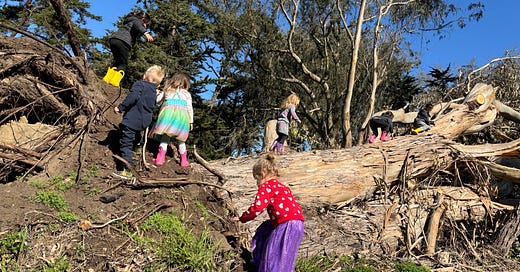




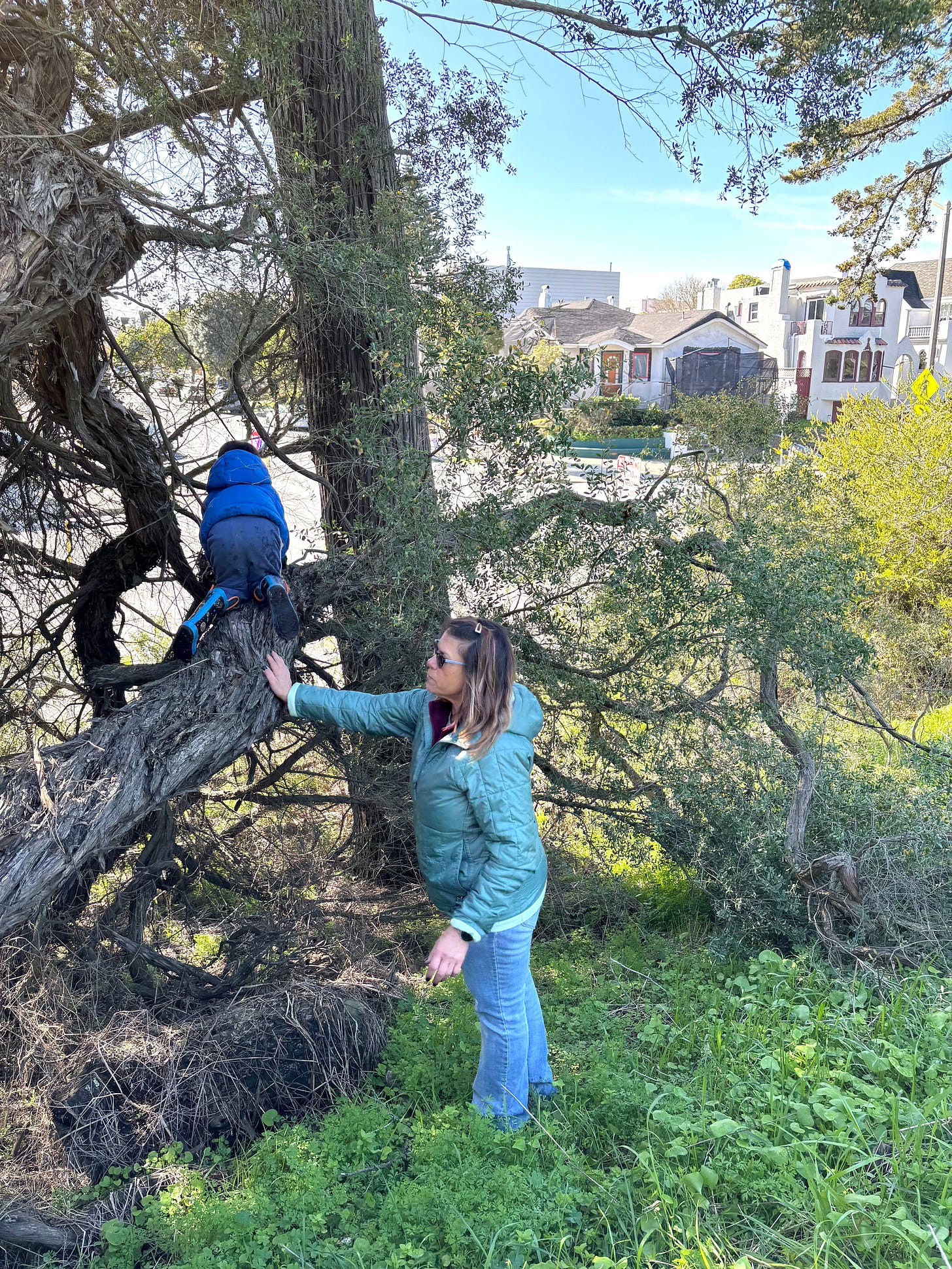
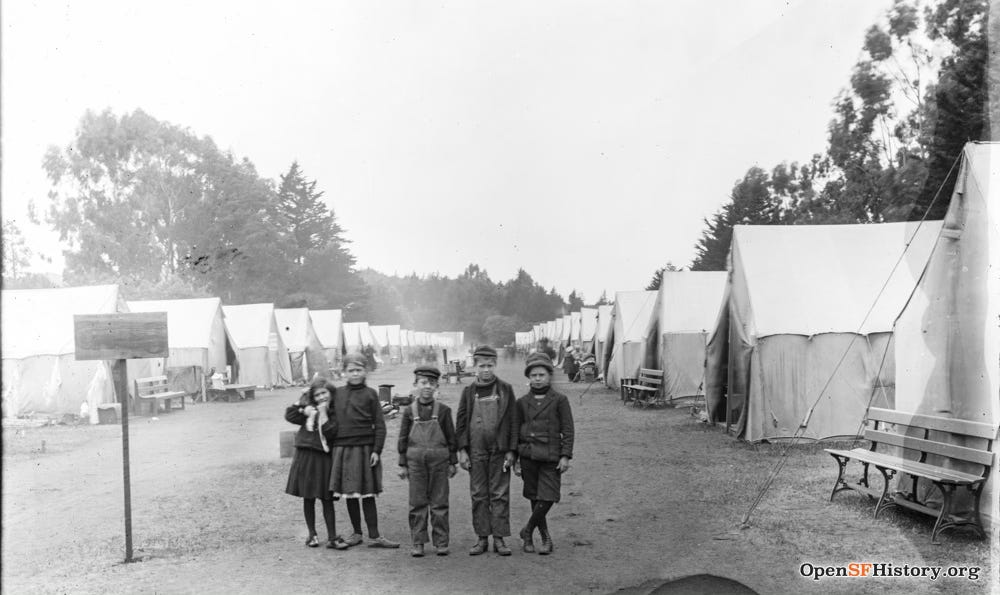
A gorgeous essay. Heartbreaking that all kids don't get to learn and play this way and inspiring that these lucky ones do.